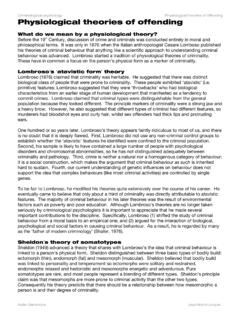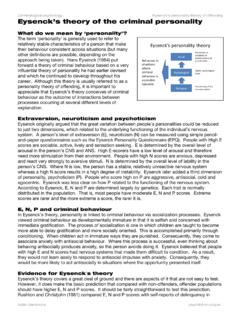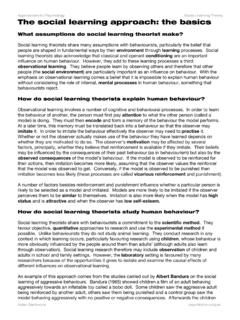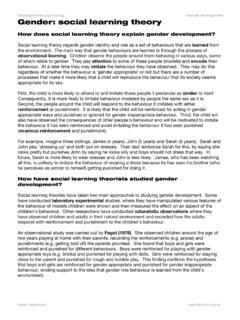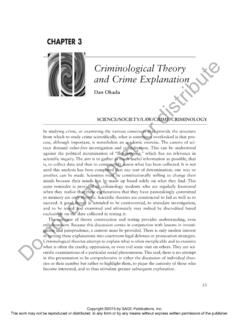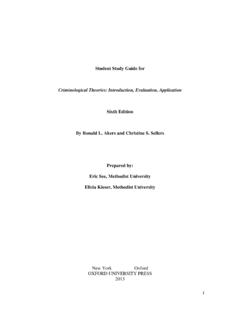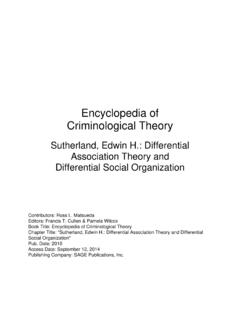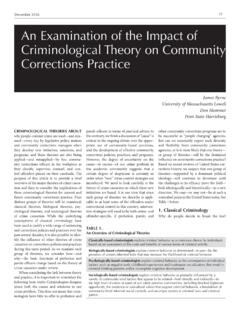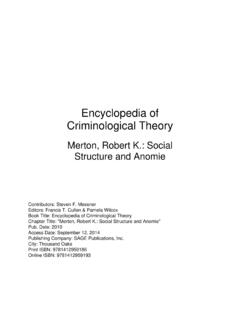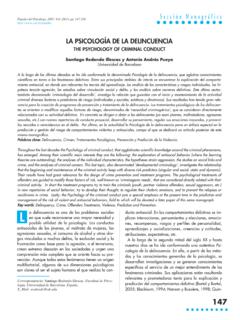Transcription of Criminological psychology Psychodynamic theories of ...
1 Criminological psychology Psychodynamic theories of offending Aidan Sammons Psychodynamic theories of offending Freud s theory of the psyche In Freud s Psychodynamic theory personality (or the psyche) has three distinct components: the id, representing primitive desires and the need for gratification, the superego, representing moral and social constraints, and the ego, representing reality and the ability to delay gratification. Within this framework it is the role of the ego to strike a balance between the demands of the id and the constraints imposed by the superego. This is primarily achieved through the use of defence mechanisms that allow the id s desires to be satisfied in ways that the superego finds acceptable. To a Freudian, then, behaviour that lies outside what society regards as acceptable be it abnormal or criminal is the result of abnormal development of the psyche. Since, in classical Freudian theory, the structure of the psyche is determined in the first five years of life, it follows that the roots of offending are also to be found in this period, especially in the relationship between the developing child and its parents.
2 The Freudian framework implies a number of possible causes for later criminal behaviour. A weak superego The superego is the moral regulator of behaviour. It develops at the end of the phallic stage (about 5 years) as the child internalises its same-sex parent in order to resolve the Oedipus complex. The superego continues to act as a parent within the psyche. It punishes the ego with anxiety when an immoral act is contemplated and with guilt of the act is carried out. A weak superego, developed as a result of abnormal relationships within the family, would result in a person with few if any of the usual inhibitions against antisocial behaviour. They would act in ways that gratified their id, regardless of the social restraints on doing so. A deviant superego Alternately, a child might develop a superego in the normal way, but the superego itself has deviant values. The superego is an internalization of the same sex parent so as a moral regulator it threatens and punishes those behaviours that the parent would find unacceptable.
3 Consequently, a son raised normally in a family with a criminal father might develop a superego that does not react to criminal acts that the father would engage in. A strong superego It seems counterintuitive that a strong superego could increase a person s risk of offending when the superego is the regulator of moral behaviour but there are at least two ways in which this might happen. An excessively powerful superego would render a person anxious and guilty much of the time, since every time they acted on the id s desires however innocuously their superego would punish them for it. This could result in a person committing crimes in order to get caught and punished to assuage the guilt imposed by their own superego. Alternately, an excessively strong superego might prevent the person from expressing any of the antisocial impulses that inevitably build up in their unconscious. Normally, they would express these impulses harmlessly through defense mechanisms ( by sublimating their aggression into sport).
4 If the superego prevents this from happening the aggression or sexual desire could build up over time until it becomes strong enough to overwhelm the ego and is expressed suddenly and violently as murder or rape. Megargee s overcontrolled violent offender Megargee (1966) documented a series of cases of violence carried out by people who were regarded as passive and harmless. For example, an 11 year-old boy who stabbed his brother 34 times with a steak knife was described as polite and softly spoken with no history of aggression (Gross, 1996). Megargee argued that such cases represent a distinct sub-group of violent offenders Criminological psychology Psychodynamic theories of offending Aidan Sammons whose shared characteristic is an apparent inability to express their anger in normal ways and who eventually explode and release all their anger and aggression at once, often in response to a seemingly trivial provocation. Freudian formulations like Megargee s are unfashionable nowadays and more research attention is given to the majority of violent offenders, whose problem is generally a lack of inhibition of their anger, rather than too much inhibition.
5 Nonetheless, there is evidence that a subset of violent offenders follow the pattern described by Megargee. Blackburn (1971), for example, found that people convicted of extremely violent assaults tended to have fewer previous convictions and scored lower on measures of hostility than those convicted of moderately violent assaults. However, the existence of such a group does not in itself show that Megargee was correct about the underlying mechanisms responsible. In particular, Megargee s approach does not adequately distinguish whether such offenders do not experience anger normally (as the Psychodynamic approach would suggest) or whether they experience it but do not do not express it (Blackburn, 1993). Bowlby s affectionless psychopath Another psychodynamically inspired explanation of offending comes from Bowlby (1951) although Bowlby was also influenced by ethology and evolutionary theory. Bowlby proposed that the ability to form meaningful social relationships in adulthood was dependent on a close, warm and continuous relationship with the mother in the first few years.
6 Since this relationship acts as the prototype for all future relationships, its disruption would impair the person s ability to relate to others. This could result in a condition Bowlby called affectionless psychopathy . Bowlby presented evidence that early maternal deprivation was related to later criminal behaviour, notably through his famous 44 Thieves study in which he reported that 39 per cent of a group of juvenile delinquents has experienced significant disruption to their attachments, compared to only 5 per cent of a non-delinquent group. Such evidence notwithstanding, it is no longer widely accepted that there is such a clear causal link between maternal deprivation and offending . Bowlby s empirical research has been criticised for unrepresentative sampling and poor control group matching. Later theorists, particularly Rutter (1971). have pointed out his failure to distinguish between deprivation, privation and the distortion of attachments, each of which may have different effects.
7 Overall, he is now regarded to have overestimated the impact of early life experiences on later offending . Evaluation of the Psychodynamic approach Psychodynamic theories of offending are no longer widely accepted by psychologists, for a number of reasons. First, there is the difficulty associated with testing some of the concepts. Psychodynamic theories rely heavily on concepts like the unconscious mind, whose existence is difficult if not impossible to prove. Second, there is a tendency for Psychodynamic theories to be able to explain any behaviour but only after it has happened. As a result, these theories are regarded by many as unprincipled and, since they are incapable of being proved wrong, unscientific. Third, Psychodynamic researchers rely heavily on qualitative case studies in which the subjects behaviour is interpreted in symbolic terms. This is a highly subjective process: two different analysts may draw very different conclusions from the same set of observations.
8 This type of evidence makes scientists, who prefer quantifiability and objectivity, rather uneasy. Fourth, Psychodynamic therapies that have attempted to treat offending have not been successful (Howitt, 2009), besides being extremely time consuming. It is important not to overlook the positive contributions that Psychodynamic theories have made to Criminological psychology . Psychodynamic researchers have pointed to the importance of childhood experiences and parent-child relationships as an influence on offending (Blackburn, 1993) and have identified many important variables relating to delinquent behaviour in adolescence (Hollin, 1989). So whilst its theoretical explanations have fallen out of favour, the Psychodynamic tradition should be credited with pointing in some useful directions for later researchers to follow.
